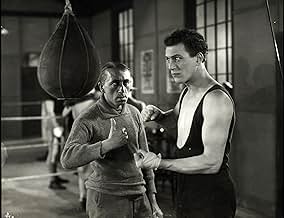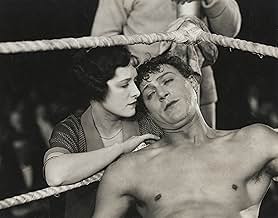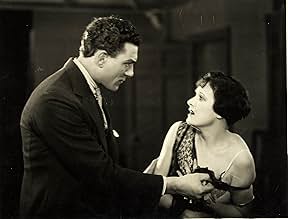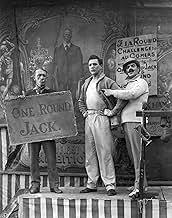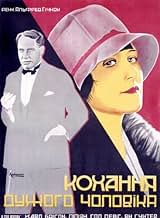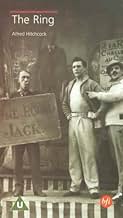AVALIAÇÃO DA IMDb
6,1/10
4,2 mil
SUA AVALIAÇÃO
Dois boxeadores competem pelo amor de uma mulher.Dois boxeadores competem pelo amor de uma mulher.Dois boxeadores competem pelo amor de uma mulher.
- Direção
- Roteiristas
- Artistas
Lillian Hall-Davis
- The Girl
- (as Lilian Hall Davis)
Eugene Corri
- Eugene Corri
- (não creditado)
Charles Farrell
- Second
- (não creditado)
Clare Greet
- Fortune Teller
- (não creditado)
Lawrence Hanray
- Clerrgyman in Black Cassock
- (não creditado)
Tom Helmore
- Spectator
- (não creditado)
Alfred Hitchcock
- Man-Dipping Attraction Worker
- (não creditado)
Minnie Rayner
- Boxing Contestant's Wife
- (não creditado)
Brandy Walker
- Spectator
- (não creditado)
Bombardier Billy Wells
- Boxer
- (não creditado)
- Direção
- Roteiristas
- Elenco e equipe completos
- Produção, bilheteria e muito mais no IMDbPro
Avaliações em destaque
This early film has its flaws-- a predictable plot and some overlong scenes of dubious relevance-- but it already clearly demonstrates Hitchcock's mastery of editing and the use of powerful images. It's also among the most expressionist of his films stylistically; note, for examples, the weird distortions he uses during the party sequence and the frequent echoes of both title and plot in the imagery.
Its core, though, remains the final match, which is still among the more exciting examples of cinematic boxing. Even though you know that the hero has to win, it becomes quite believable that he will lose, and the movement of his wife from the champion's corner to his, motivating the final plot pay-off, is very well entwined with the progress of the match. The inserts of the stopwatch do exactly what they should; you can almost hear the ticking (even though this is a silent film, the visuals often have a surprisingly auditory feel to them). The pacing becomes astonishingly rapid, and the viewer gets sucked into the excitement and brutality of both the match and the sexual jealousy which underlies it.
The only DVD release with which I am familiar is that of Laserlight, a public domain company. As with each Hitchcock silent they've released, they've attached various musical selections, mostly orchestral, to the action. The sound editing is frequently sloppy, and the sound quality varies widely, but some genuine care seems to have gone into most of the actual choices, and the music accompanying the final match works extremely well; it is unlikely that this sequence will ever be better accompanied than it is here.
This is a much more impressive film than its present obscurity would suggest. It deserves an honorable place in both the Hitchcock canon and the slender list of worthwhile boxing films.
Its core, though, remains the final match, which is still among the more exciting examples of cinematic boxing. Even though you know that the hero has to win, it becomes quite believable that he will lose, and the movement of his wife from the champion's corner to his, motivating the final plot pay-off, is very well entwined with the progress of the match. The inserts of the stopwatch do exactly what they should; you can almost hear the ticking (even though this is a silent film, the visuals often have a surprisingly auditory feel to them). The pacing becomes astonishingly rapid, and the viewer gets sucked into the excitement and brutality of both the match and the sexual jealousy which underlies it.
The only DVD release with which I am familiar is that of Laserlight, a public domain company. As with each Hitchcock silent they've released, they've attached various musical selections, mostly orchestral, to the action. The sound editing is frequently sloppy, and the sound quality varies widely, but some genuine care seems to have gone into most of the actual choices, and the music accompanying the final match works extremely well; it is unlikely that this sequence will ever be better accompanied than it is here.
This is a much more impressive film than its present obscurity would suggest. It deserves an honorable place in both the Hitchcock canon and the slender list of worthwhile boxing films.
Hitchcock displays his already developed understanding for visuals in this early silent film. The plot of the film, involving two boxers fighting over a girl, is straight-forward drama without much to recommend it. Hitchcock's talent, though, is found in his stunning use of images. Nearly every shot is filled with visual symbols. Especially memorable is the jewelry that one boxer gives the girl just before she marries the other boxer. He slides it up her arm in a clearly sexual way and with one simple movement Hitch has shown us all we need to know. The boxing scenes are handled well with some interesting point-of-view shots that again prove how far ahead of his time Hitchcock was. The film also gives insight into his later treatment of women. The object of the boxers' desires is driven by money and lust, not reason or love. The only other women in the film are either beautiful party girls who make open offers of sex or old crones who help to destroy happy relationships. All in all, the Ring is a must for anyone interested in Hitchcock's early work and his development as a visual storyteller.
The symbolic use of objects, form editing, the position of characters in the scene... these were all used with such joyous abandon by Hitchcock that you can really see what a fertile genius he had. The way the wife moves from one corner of the ring to the other as the fight progresses, the editing when the wedding ring is placed on her finger... while these may seem a bit obvious by todays standards, in the silent era they spoke volumes about the story without a word being spoken. Even the title has a least four meanings that I can see; the boxing ring, the wedding ring, the bracelet the lover buys, and the love triangle at the heart of the story.
I really wanted to like this one, even watching it twice in the past week, thinking that it might grow on me (as Hitchcock's Number Seventeen has done, slightly) but it just doesn't do anything for me. Apparently, it didn't do much for the audiences in 1927 either, because from what I've been able to find out about it, despite being popular with critics, it sank at the box office.
Hitchcock not only directed but also wrote this boring melodrama, a combination of two of my least favourite genres: boxing, and romance. The world of boxing provides the backdrop for this formulaic triangle between two competitors and the girl who loves them both: but which man does she really want to marry?
The title is good, with several layered meanings in relation to the story. The fact that the film used few title cards was unique, letting visuals tell the story by themselves. There are a lot of clever visuals by Hitchcock: as we look up through the water of a pond at the two lovers; placing the ring on her finger at the marriage ceremony, only to have the bracelet slip down to her wrist, reminding her (and the audience) of the other man; girl, sitting on hubby's lap, glances across the room toward a mirror, and sees reflection of the "other man"; fingers flittering away on the ivories, distorted - but the plot, again written by Hitchcock himself, was a routine melodrama which could hardly hold my attention.
Beautiful, slightly Gothic looking church in which the ceremony occurs is an asset to the film in its few, brief scenes. Goofball comically blowing the suds off the beer, then downing it, and the film's subsequent distorted Point-Of-View shot is an amusing moment. Was this film, released October 1927, the first to use POV shots?
Hitchcock not only directed but also wrote this boring melodrama, a combination of two of my least favourite genres: boxing, and romance. The world of boxing provides the backdrop for this formulaic triangle between two competitors and the girl who loves them both: but which man does she really want to marry?
The title is good, with several layered meanings in relation to the story. The fact that the film used few title cards was unique, letting visuals tell the story by themselves. There are a lot of clever visuals by Hitchcock: as we look up through the water of a pond at the two lovers; placing the ring on her finger at the marriage ceremony, only to have the bracelet slip down to her wrist, reminding her (and the audience) of the other man; girl, sitting on hubby's lap, glances across the room toward a mirror, and sees reflection of the "other man"; fingers flittering away on the ivories, distorted - but the plot, again written by Hitchcock himself, was a routine melodrama which could hardly hold my attention.
Beautiful, slightly Gothic looking church in which the ceremony occurs is an asset to the film in its few, brief scenes. Goofball comically blowing the suds off the beer, then downing it, and the film's subsequent distorted Point-Of-View shot is an amusing moment. Was this film, released October 1927, the first to use POV shots?
"The Ring" is, for me, Hitchcock's best silent feature. It is a nippy little romance which sprints along with a surprisingly swift pace.
There's the typical early Hitch experimentation - the camera getting "knocked out" in a boxing scene is a prime example and some fine comedic moments in what is otherwise a pretty serious story of love and betrayal although, with the boxing backdrop, the rather mundane story is slightly more exciting.
Less gimicky than the more famous "The Lodger", and therefore more believable, "The Ring" is an underrated, early effort from the man who went on to become one of the most celebrated directors in the world.
NB. Catch hold of the BFI release of this video if you can - the score is superb and by far the best new music I have heard composed for a silent movie.
There's the typical early Hitch experimentation - the camera getting "knocked out" in a boxing scene is a prime example and some fine comedic moments in what is otherwise a pretty serious story of love and betrayal although, with the boxing backdrop, the rather mundane story is slightly more exciting.
Less gimicky than the more famous "The Lodger", and therefore more believable, "The Ring" is an underrated, early effort from the man who went on to become one of the most celebrated directors in the world.
NB. Catch hold of the BFI release of this video if you can - the score is superb and by far the best new music I have heard composed for a silent movie.
Você sabia?
- CuriosidadesAccording to the dialogue card at 1:19:06, the big fight between Jack Saunders and Bob Corby was refereed by Eugene Corri, who entered the ring wearing a tux. Corri made boxing history in December 1907 by being the first referee to referee inside the ring during a fight.
- Erros de gravaçãoDuring the first boxing scene, when the assistant is helping the sailor put on his coat, the coat is on nearly all the way; then, in the next shot, it is shown being put back on again.
- Citações
The Promoter: If you win this next fight with the nigger, you'll be in the running for the championship.
- ConexõesFeatured in Silent Britain (2006)
Principais escolhas
Faça login para avaliar e ver a lista de recomendações personalizadas
- How long is The Ring?Fornecido pela Alexa
Detalhes
- Tempo de duração
- 1 h 56 min(116 min)
- Mixagem de som
- Proporção
- 1.33 : 1
Contribua para esta página
Sugerir uma alteração ou adicionar conteúdo ausente

